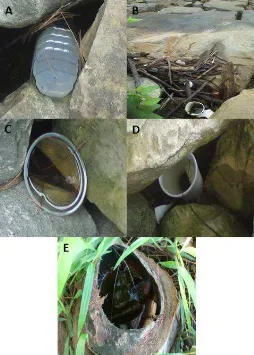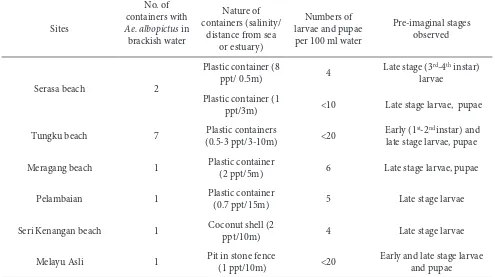Vol. 38, no. 1 Journal of Vector Ecology 197
Scientiic Note
Detection of
Aedes albopictus
pre-imaginal stages
in brackish water habitats in Brunei
Darussalam
Fakhriedzwan Hj. Idris
1, Abdulai Usman
1, Sinnathamby N. Surendran
2,
and
Ranjan Ramasamy
1*1Institute of Health Sciences, Universiti Brunei Darussalam, Gadong, Brunei Darussalam BE1410, [email protected] 2 Department of Zoology, University of Jaffna, Jaffna, Sri Lanka
he mosquitoes Aedes (Stegomyia) albopictus Skuse and Aedes (Stegomyia) aegypti (Linnaeus) are vectors of dengue, chikungunya, and other arboviruses and are widely regarded to undergo pre-imaginal development only in freshwater habitats. As there is no vaccine or speciic drug for dengue, eliminating or larviciding the freshwater habitats of the vectors are important strategies for controlling dengue worldwide. However, such measures have failed to eradicate dengue from Brunei Darussalam, with an incidence of 73 cases per 100,000 persons in 2010, and other Southeast Asian countries with extensive coastal areas (Arima and Matsui 2011, Chun et al. 2007).hey also did not prevent recent epidemics of chikungunya in Asia (Lobo et al. 2011, Surendran et al. 2007, Weaver and Reisen 2010). Two-iths of the world’s population is now at risk from dengue, which shows an increasing incidence and global spread. Aedes aegypti and Ae. albopictus were recently shown to oviposit and undergo pre-imaginal development in brackish water (fresh, brackish, and saline waters are deined as containing <0.5, 0.5 to 30, and >30 parts per thousand (ppt) salt, respectively) in discarded plastic and glass containers, abandoned boats, and wells in coastal areas of Sri Lanka in South Asia (Ramasamy et al. 2011, Surendran et al. 2012). Such brackish water habitats are potential sources of vectors that may contribute to the transmission of dengue and other arboviral diseases in coastal areas. We therefore investigated the possible presence of Ae. aegypti and Ae. albopictus larvae in brackish water collections along the South China Sea coast of Brunei Darussalam, a dengue-endemic Southeast Asian country where dengue is known to occur in coastal areas (Chun et al. 2007).
Approximately 300 potentially brackish stagnant water collections in natural pools or discarded food and beverage containers along beaches, estuaries, and lagoons were examined for the presence of Ae. aegypti and Ae. albopictus larvae and pupae at 12 locations along the South China Sea coast of Brunei Darussalam. his work was carried out between December and March in 2010/2011 and 2011/2012, which is a relatively dry season in Brunei Darussalam. he 12 locations in three of the four administrative districts of Brunei Darussalam were selected for the survey because of their position on the outskirts of major urban centers as well as ease of access. Inundations at high tides and sea spray were the likely cause of brackishness in the studied water collections.
When pre-imaginal stages were observed, they were collected with a Pasteur pipette, transferred with the habitat water to plastic containers, and brought to the laboratory for identiication using standard keys (Barraud 1934, Rueda 2004).Salinity was measured
with a salinity refractometer (Atago, Japan) and conirmed where necessary with a conductivity meter (Hach, CO, U.S.A.). he instruments were pre-calibrated with solutions of 0 to 30 ppt sodium chloride in the laboratory.
Salinity tolerance of Ae. albopictus in the laboratory was irst investigated by allowing batches of 85 eggs each, collected from fresh water ovitraps, to hatch and develop into adults at salinities of 0 to 20 ppt, essentially as described by Ramasamy et al. (2011). Rain water was mixed in diferent proportions with 27 ppt salinity sea water in Petri dishes for the experiment. Based on the result, the development of 1st instar larvae from batches of 50 eggs each were subsequently tested in three replicates at both 8 and 10 ppt salinity essentially as described (Ramasamy et al. 2011). he approximate level of salinity producing 50% failure of 1st instar larvae to emerge as adults (LC50) was determined by graphical analysis.
Pre-imaginal stages of Ae. albopictus were found in 13 brackish water collections of 0.5 to 8 ppt salinity at six sites: four beaches (Serasa, Tungku, Meragang, and Seri Kenangan) and two estuarine villages (Pelambaian and Melayu Asli) (Figure 1). he six sites were located on the suburban outskirts of the city of Bandar Seri Begawan, which is the national capital and the capital of the Brunei-Muara district, as well as the towns of Kuala Belait and Tutong that are respective district capitals of the Belait and Tutong districts (Figure 1). Immature stages of Ae. albopictus were also observed in fresh water collections in some of the surveyed sites. Table 1 summarizes relevant characteristics of the brackish water habitats containing Ae. albopictus with illustrative photographs in Figure 2. Aedes aegypti, although common in fresh water containers in houses in urban Brunei Darussalam (Chun et al. 2007 and our unpublished observations), was not found in brackish or fresh water at any of the 12 peri-urban locations studied. Culicine larvae that did not belong to the genus Aedes were also found in ive brackish water collections of up to 10 ppt salinity at four sites as well as fresh water in diferent study sites.
198 Journal of Vector Ecology June 2013 he presence of the pre-imaginal stages of Ae. albopictus in brackish water of up to 8 ppt salinity in peri-urban settings in Brunei Darussalam builds on data from Sri Lanka that show Ae. albopictus in urban and peri-urban habitats of up to 14 ppt salinity (Ramasamy et al. 2011, Surendran et al. 2012). he LC50 for salinity in the transformation of 1st instar larvae of Ae. albopictus to adults in the Jafna peninsula of Sri Lanka was 13 ppt, with 100% survival to adulthood seen at 10 ppt salinity (Ramasamy et al. 2011). he possible higher salinity tolerance of Ae. albopictus in the Jafna peninsula compared with Brunei Darussalam and a coastal location in mainland Sri Lanka may be attributed to adaptation to the more extensive groundwater salinization in the peninsula (Ramasamy et al. 2011, Surendran et al. 2012, Ramasamy and Surendran 2012).
he salinity of the observed brackish water habitats along the Brunei Darussalam coast could have conceivably changed over time due to the combined efects of rainfall, sea spray, and tides. Hence, it is possible that the developmental sequence from oviposition to adult emergence may occur at diferent salinities. More detailed studies are needed to evaluate such possible salinity changes and their impact on mosquito development. Signiicant hatching of eggs and pre-imaginal development of Ae. albopictus to adulthood at up to 8 ppt salinity in the laboratory, however, supports the view that the same process can also happen in brackish water habitats in the environment in Brunei Darussalam.
he greater preference of Ae. aegypti to rest and oviposit indoors (endophilicity) or closer to houses than Ae. albopictus (Barraud 1934) may be one reason for not detecting Ae. aegypti in the present study. he Sri Lankan sites where Ae. aegypti were found in brackish water (Ramasamy et al. 2011, Surendran et al. 2012) had a greater population density and attendant shorter distances between the coastal habitats and houses than the sites investigated in Brunei Darussalam. Brackish-water development shown in the present study to occur in Brunei Darussalam for Ae. albopictus, and previously in Sri Lanka for Ae. aegypti and Ae. albopictus (Ramasamy et al. 2011, Surendran et al. 2012), could be a widespread phenomenon that can contribute to the transmission of dengue and other arboviral diseases in coastal areas. Ae. albopictus has been associated with recent outbreaks of dengue and chikungunya in continental Europe (Rezza et al. 2007, La Ruche et al. 2010), and dengue in southern China (Peng et al. 2012) and many islands worldwide (Rezza 2012). Ae. albopictus adapted to tolerate cold temperatures and/or salinity can therefore potentially become an increasingly important vector in the transmission of dengue and other arboviral diseases worldwide.
Acknowledgments
We thank K. Yassin and the staf of the Entomology and Parasitology unit of the Ministry of Health, Brunei Darussalam, for advice on mosquito collection and identiication.
REFERENCES CITED
Arima, Y. and T. Matsui. 2011. Epidemiologic update on the dengue situation in the Western Paciic Region. WPSAR. 2: doi:10.5365/wpsar.2011.2.2.005.
Barraud, P.J. 1934. Diptera Vol V. Family Culicidae. Tribes Figure 1. Map of Brunei Darussalam showing the six coastal sites
with brackish water collections that contained Aedes albopictus pre-imaginal stages (red circles).
Vol. 38, no. 1 Journal of Vector Ecology 199
Megarhinini and Culicini. In: he Fauna of British India, Including Ceylon and Burma. R.B.S. Sewell and P.W. Edwards (eds.) Taylor and Francis. London.
Chun, L., P.U. Telisinghe, M.M. Hossain, and R. Ramasamy. 2007. Vaccine development against dengue and shigellosis and implications for control of the two diseases in Brunei. Brunei Darussalam J. Hlth. 2: 60-71.
La Ruche, G., Y. Souarès, A. Armengaud, F. Peloux-Petiot, P. Delaunay, P. Desprès, A. Lenglet, F. Jourdain, I. Leparc-Gofart, F. Charlet, L. Ollier, K. Mantey, T. Mollet, J.P. Fournier, R. Torrents, K. Leitmeyer, P. Hilairet, H. Zeller, W. Van Bortel, D. Dejour-Salamanca, M. Grandadam, and M. Gastellu-Etchegorry. 2010. First two autochthonous dengue virus infections in metropolitan France, September 2010. Euro Surveill. 15(39): pii=19676.
Lobo, D.A., R.Velayudhan, P. Chatterjee, H. Kohli, and P. J. Hotez. 2011. he neglected tropical diseases of India and South Asia: review of their prevalence, distribution, and control or elimination. PLoS Negl. Trop. Dis. 5(10): e1222. doi:10.1371/ journal.pntd.0001222.
Peng, H.J., H.B. Lai, Q.L. Zhang, B.Y. Xu, H. Zhang, W.H Liu, W. Zhao, Y.P. Zhou, X.G. Zhong, S. Jiang, J.H. Duan, G.Y. Yan, J.F. He, and X.G. Chen. 2012. A local outbreak of dengue caused by an imported case in Dongguan China. BMC Publ. Hlth. 12: 83. doi:10.1186/1471-2458-12-83.
Ramasamy, R., S.N. Surendran, P.J. Jude, S. Dharshini, and M. Vinobaba. 2011. Larval development of Aedes aegypti and Aedes albopictus in peri-urban brackish water and its implications for transmission of arboviral diseases. PLoS Negl. Trop. Dis. 5: e1369. doi:10.1371/journal.pntd.0001369.
Ramasamy, R. and S.N. Surendran. 2011. Possible impact of rising sea levels on vector-borne infectious diseases. BMC Infect. Dis. 11: 18. doi:10.1186/1471-2334-11-18.
Ramasamy, R. and S.N. Surendran. 2012. Global climate change and its potential impact on disease transmission by salinity-tolerant mosquito vectors in coastal zones. Front. Physiol. (Systems Biology) 3: 198. doi: 10.3389/fphys.2012.00198. Rezza, G. 2012. Aedes albopictus and the reemergence of dengue.
BMC Publ. Hlth. 12:72. doi:10.1186/1471-2458-12-72. Rezza, G., L. Nicoletti, R. Angelini, R. Romi, A.C. Finarelli, M.
Panning, P. Cordioli, C. Fortuna, S. Boros, F. Magurano, G. Silvi, P. Angelini, M. Dottori, M. G. Ciufolini, G.C. Majori, and A. Cassone. 2007. Infection with chikungunya virus in Italy: an outbreak in a temperate region. Lancet 370: 1840–1846. Rueda, L.M. 2004. Pictorial keys to the identiication of
mosquitoes (Diptera: Culicidae) associated with dengue virus transmission. Zootaxa 589: 42-49.
Surendran, S.N., S. Kannathasan, A. Kajatheepan, and P.J. Jude. 2007. Chikungunya-type fever outbreak: some aspects related to this new epidemic in Jafna district, northern Sri Lanka. Trop. Med. Hlth. 35: 249-252.
Surendran, S.N., P.J. Jude, V. habothiny, S. Raveendran, and R. Ramasamy. 2012. Pre-imaginal development of Aedes aegypti in brackish and fresh water urban domestic wells in Sri Lanka. J. Vector Ecol. 37: 471-473.
Weaver, S.C. and W.K. Reisen. 2010. Present and future arboviral threats. Antiviral Res. 85: 328. doi:10.1016/j. antiviral.2009.10.008.
Sites
No. of containers with Ae. albopictus in brackish water
Nature of containers (salinity/
distance from sea or estuary)
Numbers of larvae and pupae per 100 ml water
Pre-imaginal stages observed
Serasa beach 2
Plastic container (8
ppt/ 0.5m) 4
Late stage (3rd-4th instar) larvae
Plastic container (1
ppt/3m) <10 Late stage larvae, pupae
Tungku beach 7 Plastic containers
(0.5-3 ppt/3-10m) <20
Early (1st-2nd instar) and late stage larvae, pupae
Meragang beach 1 Plastic container
(2 ppt/5m) 6 Late stage larvae, pupae
Pelambaian 1 Plastic container
(0.7 ppt/15m) 5 Late stage larvae
Seri Kenangan beach 1 Coconut shell (2
ppt/10m) 4 Late stage larvae
Melayu Asli 1 Pit in stone fence
(1 ppt/10m) <20

